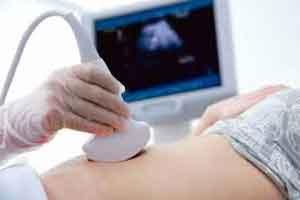- Home
- Editorial
- News
- Practice Guidelines
- Anesthesiology Guidelines
- Cancer Guidelines
- Cardiac Sciences Guidelines
- Critical Care Guidelines
- Dentistry Guidelines
- Dermatology Guidelines
- Diabetes and Endo Guidelines
- Diagnostics Guidelines
- ENT Guidelines
- Featured Practice Guidelines
- Gastroenterology Guidelines
- Geriatrics Guidelines
- Medicine Guidelines
- Nephrology Guidelines
- Neurosciences Guidelines
- Obs and Gynae Guidelines
- Ophthalmology Guidelines
- Orthopaedics Guidelines
- Paediatrics Guidelines
- Psychiatry Guidelines
- Pulmonology Guidelines
- Radiology Guidelines
- Surgery Guidelines
- Urology Guidelines
Late third trimester ultrasound scan beneficial, may detect missed fetal abnormalities, finds study

Assessment of pregnancy at 35–37 weeks' gestation is useful in the prediction of subsequent development of pre‐eclampsia and delivery of a small‐ or large‐for‐gestational‐age neonate. An additional benefit of such ultrasound examination is the detection of a previously undiagnosed fetal abnormality, because, first, it was missed during previous scans, which are commonly performed routinely at 11–13 and 18–24 weeks' gestation, second, the phenotypic expression of the abnormality becomes apparent only after 20 weeks, such as short limbs in the case of achondroplasia, dilated bowel in the case of bowel atresia or abnormal shape of the head in the case of craniosynostosis, or, third, the abnormality develops only during the third trimester, such as ovarian cysts in response to maternal estrogenic stimulation or ventriculomegaly following fetal brain haemorrhage or maternal infection.
In a study published in Ultrasound in Obstetrics & Gynecology that involved more than 50,000 pregnancies, a fetal anomaly was detected for the first time in the third trimester in one in 200 women who had undergone a first and/or second trimester ultrasound examination.
Dr A. Ficara at Fetal Medicine Research Institute, King's College Hospital, London, UK and colleagues conducted a prospective study to investigate the potential value of routine ultrasound examination at 35–37 weeks' gestation in the diagnosis of previously unknown fetal abnormalities.
The researchers evaluated 52 400 singleton pregnancies attending for a routine ultrasound examination at 35 + 0 to 36 + 6 weeks' gestation; all pregnancies had a previous scan at 18–24 weeks and 47 214 also had a scan at 11–13 weeks. We included pregnancies resulting in live birth or stillbirth but excluded those with a known chromosomal abnormality. Abnormalities were classified according to the affected major organ system, and the type and incidence of new abnormalities were determined.
Most of the fetal abnormalities (68%) seen at 35 to 37 weeks had already been diagnosed in the first and/or second trimester, and the incidence of abnormalities first seen at 35 and 37 weeks was 0.5%.
The study highlights the benefit of a late third-trimester scan for detecting fetal abnormalities that were either missed in the previous first and second trimester scans or became apparent only during the third trimester. The researchers concluded that a high proportion of fetal abnormalities are detected for the first time during a routine ultrasound examination at 35–37 weeks' gestation. Such diagnosis and subsequent management, including a selection of timing and place for delivery and postnatal investigations, could potentially improve postnatal outcome.
For more details click on the link: http://dx.

Disclaimer: This site is primarily intended for healthcare professionals. Any content/information on this website does not replace the advice of medical and/or health professionals and should not be construed as medical/diagnostic advice/endorsement or prescription. Use of this site is subject to our terms of use, privacy policy, advertisement policy. © 2020 Minerva Medical Treatment Pvt Ltd